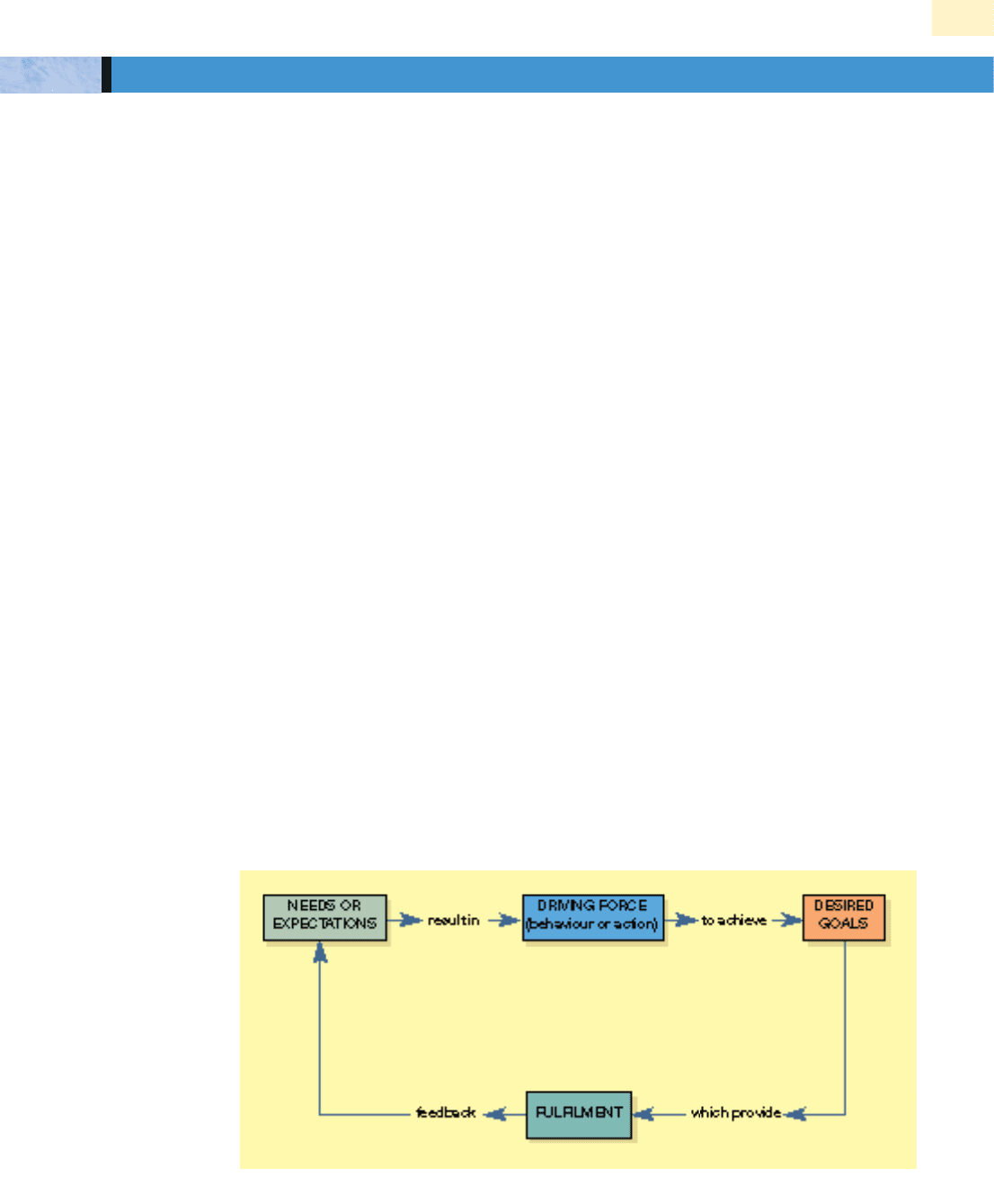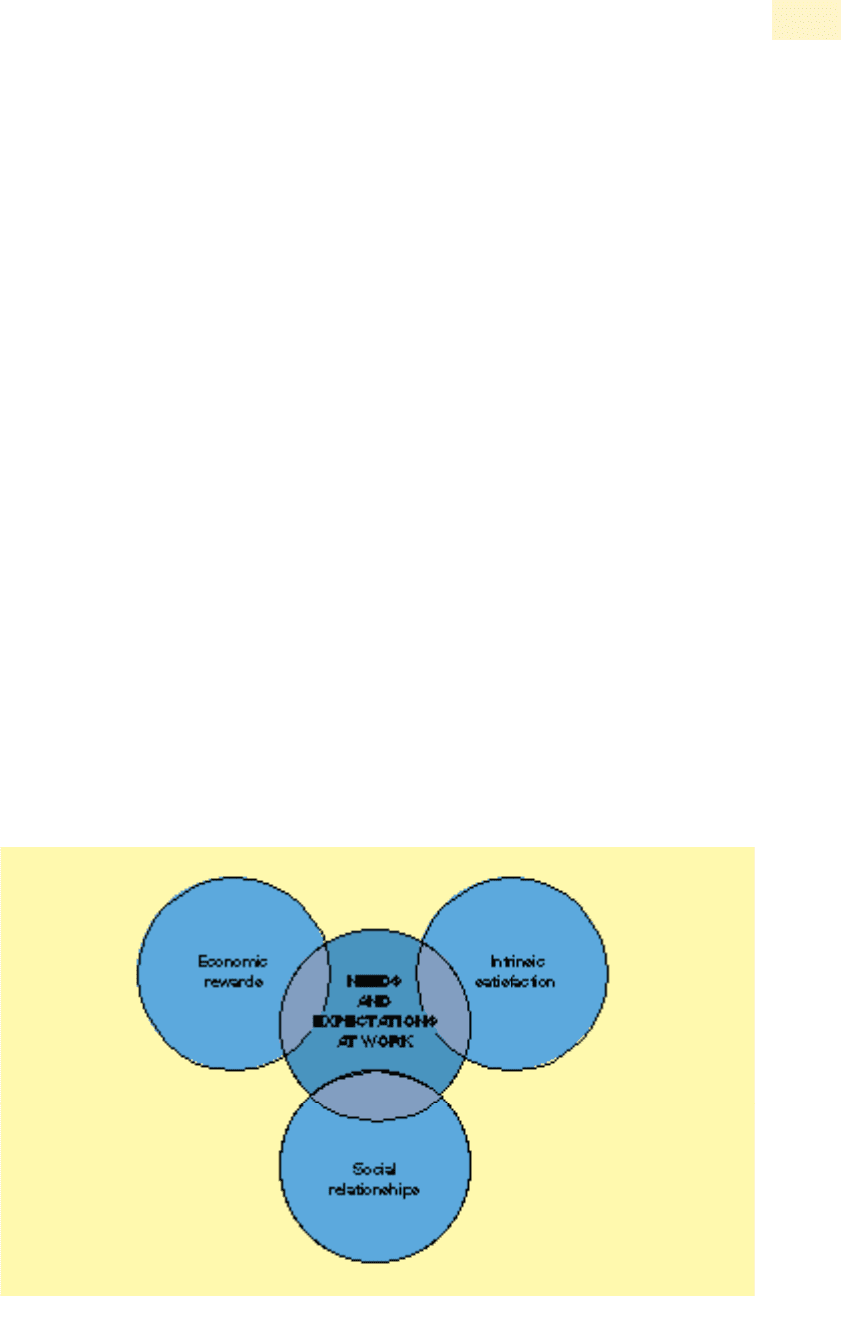Mullins L.J. Management and organisational behaviour, Seventh edition
Подождите немного. Документ загружается.


CHAPTER 11 THE PROCESS OF PERCEPTION
Stroop – illustrative experiment
a Write two vertical lists of 20 colour names in felt tip pen. For the first list use the correct
colour pen for the colour word you are writing (for example, blue pen for the word blue).
Repeat some of the colours but place them in random order.
b For the second list, use different colour pens for the colour word (for example, use a red pen
for the word blue).
c Now ask a colleague to read out loud the colour that the word is written in (not the word
itself). Compare the amount of time it takes your colleague to read out the two lists. The
second list probably not only took longer, but had more mistakes and more hesitations.
William Stroop, who first conducted this experiment, noted that the task interferes with
expected behaviour. It is difficult to stop yourself from reading the word (the result of our early
learning) which in this case directly impairs performance.
During the period of one week carefully review all the media (television, radio, advertisements,
Internet, films, newspapers and magazines) for evidence of traditional male and female
stereotypes. In a small group discussion, critically evaluate the impact and power of these
stereotypes. Compare your findings and evaluation with other groups. What conclusions do
you draw from this assignment?
ASSIGNMENT 1
ASSIGNMENT 2
465

PART 4 THE INDIVIDUAL
OBJECTIVES
Completing this exercise should help you to enhance the following skills:
Distinguish between facts and assumptions or inferences.
Examine the basis upon which you make judgements.
Review the nature of your decision-making processes.
EXERCISE
After reading the following story you are required to:
1 Read the 15 statements about the story and check each to indicate whether you consider
it to be true, false or ?
‘T’ means that the statement is definitely true on the basis of the information presented in
the story.
‘F’ means that it is definitely false.
‘?’ means that it may be either true or false and that you cannot be certain of which on
the basis of the information presented in the story. If any part of a statement is doubtful,
mark it ‘?’.
Answer each statement in turn. You may refer to the story as often as needed but do not
go back to change any answer later and do not re-read any statements after you have
answered them.
2 After you have completed checking all 15 statements, work in small groups of three to five
and discuss your individual answers. How much agreement is there among members of
your group? Do not change any of your first individual answers. However, if as a result of
your group discussion you would now give a different answer to any of the statements,
note this alongside your original answer.
The story
A businessman had just turned off the lights in the store when a man appeared and
demanded money. The owner opened a cash register. The contents of the cash register were
scooped up, and the man sped away. A member of the police force was notified promptly.
PERSONAL AWARENESS AND SKILLS EXERCISE
466

CHAPTER 11 THE PROCESS OF PERCEPTION
467
Statements about the story
1A man appeared after the owner had turned off his store lights. T F ?
2 The robber was a man. T F ?
3 The man who appeared did not demand money. T F ?
4 The man who opened the cash register was the owner. T F ?
5 The storeowner scooped up the contents of the cash register T F ?
and ran away.
6 Someone opened a cash register. T F ?
7 After the man who demanded the money scooped up the contents T F ?
of the cash register, he ran away.
8While the cash register contained money, the story does not state T F ?
how much.
9 The robber demanded money of the owner. T F ?
10 A businessman had just turned off the lights when a man appeared T F ?
in the store.
11 It was broad daylight when the man appeared. T F ?
12 The man who appeared opened the cash register. T F ?
13 No one demanded money. T F ?
14 The story concerns a series of events in which only three persons are T F ?
referred to: the owner of the store, a man who demanded money, and
a member of the police force.
15 The following events occurred: someone demanded money, a cash T F ?
register was opened, its contents were scooped up, and a man
dashed out of the store.
DISCUSSION
■ How would you explain differences in individual perceptions of the same statement?
■ On what basis did members of your group give different answers and how did their per-
ception of the statements about the story differ?
■ To what extent can you be absolutely certain about anything?
Visit our website www.booksites.net/mullins for further questions, annotated weblinks,
case material and Internet research material.

PART 4 THE INDIVIDUAL
468
1. Bartlett, F. C. Remembering Cambridge, Cambridge
University Press (1932).
2. Kohler, I. ‘The Formation and Transformation of the
Visual World’, Psychological Issues, 3, 1964, pp. 28–46,
116–33.
3. Bexton, W., Heron, W. and Scott, T. ‘Effects of
Decreased Variation in the Sensory Environment’,
Canadian Journal of Psychology, vol. 8, 1954, pp. 70–6.
4. Briggs-Myers, I. Introduction to Type, Oxford
Psychologists Press (1987).
5. Witkin, H. A., Lewis, H. B., Hertzman, M., Machover,
K., Meissner, P. P. and Wapner, S. S. Personality Through
Perception, Harper & Row (1954).
6. Ling, C. and Masako, I. ‘Intercultural Communication
and Cultural Learning: the experience of visiting
Japanese students in the US’, The Howard Journal of
Communications, vol. 14, 2003, pp. 75–96.
7. Hall E. T. ‘The Silent Language of Overseas Business’,
Harvard Business Review, vol. 38, no. 3, 1960, pp. 85–7.
8. Block, J. R. and Yuker, H. E. Can You Believe Your Eyes?,
Robson Books (2002).
9. Morgan, C. T. and King, R. A. Introduction to Psychology,
Third edition, McGraw-Hill (1966), p. 343.
10. Luthans, F. Organizational Behaviour, Seventh edition,
McGraw-Hill (1995), p. 96.
11. For further examples of perceptual teasers, see Tosi, H.
L., Rizzo, J. R. and Carroll, S. J. Managing Organizational
Behaviour, Third edition, Blackwell (1994).
12. Stroop, J. R. ‘Studies of Interference in Serial Verbal
Reactions’, Journal of Experimental Psychology, vol. 4, no.
18, 1935, pp. 643–62; and Penrose, L. S. and Penrose,
R. ‘Impossible Objects: A Special Type of Illusion’,
British Journal of Psychology, part 1, February 1958.
13. Wexley, K. N., Yukl, G. A., Kovacs, S. Z. and Sanders,
R. E. ‘Importance of Contrast Effects in Employment
Interviews’, Journal of Applied Psychology, 56, 1972,
pp. 45–8.
14. Laing, R. D. Knots, Penguin (1971), p. 30.
15. Guirdham, M. Interactive Behaviour at Work, Third edi-
tion, Financial Times Prentice Hall (2002).
16. See, for example: Pivcevic, P. ‘Taming the Boss’,
Management Today, March 1999, pp. 68–72.
17. Bandler, R., Grinder, J., Dilts, R. and Delozier, J. Neuro
Linguistic Programming Volume I: The study of the struc-
ture of subject experience, Meta Publications (1980).
18. Leading Edge Communications Ltd. How to become
an irresistible and hypnotic communicator, p.2
http://www.nlpandhypnosis.com [accessed 1.12.03].
19. McCann, D. How to Influence Others at Work, Second
edition, Butterworth Heinemann (1993).
20. Berne, E. Games People Play, Penguin (1966).
21. See, for example: Stewart, I. and Jaines, V. TA today: A
New Introduction to Transactional Analysis, Life Space
Publishing (1987).
22. Kendon, A. ‘Some Functions of Gaze Direction in
Social Interaction’, Acta Psychologica, 26, 1967,
pp. 22–63.
23. Mehrabian, A. Nonverbal Communication, Aldine
Atherton (1972).
24. Cook, M. Interpersonal Perception, Penguin (1971).
25. Schneider, S. C. and Barsoux, J. Managing Across
Cultures, Second edition, Financial Times Prentice Hall
(2003), p. 29.
26. Goffman, E. The Presentation of Self in Everyday Life,
Penguin (1971).
27. Asch, S. E. ‘Forming Impressions on Personality’,
Journal of Abnormal and Social Psychology, 41, 1946,
pp. 258–90.
28. Miller, N. and Campbell, D. T. ‘Recency and Primacy in
Persuasion as a Function of the Timing of Speeches and
Measurements’, Journal of Abnormal and Social
Psychology, 59, 1959, pp. 1–9.
29. Hodges, B. ‘Effect of Volume on Relative Weighting in
Impression Formation’, Journal of Personality and Social
Psychology, 30, 1974, pp. 378–81.
30. Gahagan, J. Interpersonal and Group Behaviour, Methuen
(1975).
31. Green, J. ‘When Was Your Management Style Last
Applauded?’, Chartered Secretary, December 1998, p. 28.
32. Wilson, P. R. ‘Perceptual Distortion of Height as a
Function of Ascribed Academic Status’, Journal of Social
Psychology, no. 74, 1968, pp. 97–102.
33. See, for example: Torrington, D. Face-to-Face in
Management, Prentice-Hall (1982).
34. Mehrabian, A. Tactics of Social Influence, Prentice-Hall
(1970).
35. Pivcevic, P. ‘Taming the Boss’, Management Today,
March 1999, p. 70.
36. McGuire, T. ‘Don’t Just Listen’, Chartered Secretary,
September 1998, p. 24.
37. James, J. Body Talk at Work, Judy Piatkus (2001), p. 3.
38. Fletcher, W. ‘Let Your Body Do The Talking’,
Management Today, March 2000, p. 30.
39. Mann, S. ‘Message in a Body’, Professional Manager,
November 2000, pp. 32–3; and Ribbens, G. and
Thompson, R. Understanding Body Language in a Week,
Institute of Management and Hodder & Stoughton (2000).
40. See, for example: Green, J. ‘Can You Read Other
People’s Body Talk?’ Administrator, February 1994,
pp. 8–9.
41. For other examples of cultural differences, see
Schneider S. C. and Barsoux, J. Managing Across
Cultures, Second edition, Finacial Times Prentice Hall
(2003).
42. Heider, F. The Psychology of Interpersonal Relations, John
Wiley and Sons (1958).
43. Kelley, H. H. ‘The Process of Causal Attribution’,
American Psychologist, February 1973, pp. 107–28.
44. Mitchell, T. R. People in Organizations: An Introduction to
Organizational Behaviour, Third edition, McGraw-Hill
(1987).
45.
Bartunek, J. M. ‘Why Did You Do That? Attribution
Theory in Organizations’, Business Horizons, September–
October 1981, pp. 66–71.
NOTES AND REFERENCES

CHAPTER 11 THE PROCESS OF PERCEPTION
469
46. Mitchell, T. R., Smyser, C. M. and Weed, S. E. ‘Locus of
Control: Supervision and Work Satisfaction’, Academy
of Management Journal, September 1975, pp. 623–31.
47. Durand, D. E. and Nord, W. R. ‘Perceived Leader
Behaviour as a Function of Personality Characteristics
of Supervisors and Subordinates’, Academy of
Management Journal, September 1976, pp. 427–38.
48. For a more detailed analysis of the accuracy of interper-
sonal perception and problems in judgement of others,
see: Krech, D., Crutchfield, R. S. and Ballachey, E. L.
Individual in Society, McGraw-Hill (1962).
49. For a fuller discussion see, for example: McKenna, E. F.
Business Psychology and Organisational Behaviour,
Lawrence Erlbaum (1994).
50. See, for example: Atkin, A. ‘Positive HIV and AIDS
Policies at Work’, Personnel Management, December
1994, pp. 34–7.
51. See also, Goss, D. and Adam-Smith, D. Organizing Aids,
Taylor & Francis (1995).
52. Cooper, C. and Davidson, M. High Pressure: Working
Lives of Women Managers, Fontana (1982).
53. Ames, A. ‘Visual Perception and the Rotating
Trapezoidal Window’, Psychological Monographs, vol. 65,
no. 7, 1951.
54. Hicks, L. ‘Gender and Culture: A Study of the Attitudes
Displayed by Managers in the Hotel World’,
Unpublished doctoral thesis, University of Surrey, 1991.
55. Hamilton, K. ‘The Women Who Move Britain’,
Management Today, March 1999, pp. 39–44.
56. Wheatcroft, P. ‘Britain’s 50 Most Powerful Women’,
Management Today, April 2000, p. 48.
FT
Use the Financial Times to enhance your understanding of the context and practice of management and
organisational behaviour. Refer to article 12 in the BUSINESS PRESS section at the end of the book for
relevant reports on the issues explored in this chapter.

Motives do not operate in a vacuum, and the
behaviour in which they do operate is affected
by the processes of perception, learning and
thinking. Theories of motivation ought to be
related to theories of learning and perception.
Robert Woodworth
Dynamics of Behaviour, Columbia University Press (1918)
There aren’t many motivating forces more
potent than giving your staff an opportunity to
exercise and express their idealism.
Anita Roddick
Business As Unusual, Thorsons (2000)
WORK MOTIVATION
AND REWARDS
The relationship between the organisation and
its members is influenced by what motivates
them to work and the rewards and fulfilment
they derive from it. The manager needs to know
how best to elicit the co-operation of staff and
direct their performance to achieving the goals
and objectives of the organisation. The
manager must understand the nature of human
behaviour and how best to motivate staff so
that they work willingly and effectively.
LEARNING OUTCOMES
After completing this chapter you should be able to:
explain the meaning and underlying concept of
motivation;
detail main types of needs and expectations of people
at work;
explain frustation-induced behaviour and possible
reactions to frustration at work;
contrast content and process theories of motivation;
examine main theories of motivation and evaluate
their relevance to particular work situations;
explain the importance of the motivation of knowledge
workers and a climate of creativity;
review the complex nature of work motivation and
rewards.
result in to
a
feedback whic
h
NEEDS OR
EXPECTATIONS
DRIVING FORCE
(behaviour or action)
FULFILMENT
12
Photo: Simon Reddy/Travel Ink

The study of motivation is concerned, basically, with why people behave in a certain
way. The basic underlying question is ‘why do people do what they do?’
1
In general
terms, motivation can be described as the direction and persistence of action. It is con-
cerned with why people choose a particular course of action in preference to others,
and why they continue with a chosen action, often over a long period, and in the face
of difficulties and problems.
2
From a review of motivation theory, Mitchell identifies four common characteristics
which underlie the definition of motivation.
3
■ Motivation is typified as an individual phenomenon. Every person is unique and
all the major theories of motivation allow for this uniqueness to be demonstrated in
one way or another.
■ Motivation is described, usually, as intentional. Motivation is assumed to be
under the worker’s control, and behaviours that are influenced by motivation, such
as effort expended, are seen as choices of action.
■ Motivation is multifaceted. The two factors of greatest importance are: (i) what
gets people activated (arousal); and (ii) the force of an individual to engage in
desired behaviour (direction or choice of behaviour).
■ The purpose of motivational theories is to predict behaviour. Motivation is not
the behaviour itself, and it is not performance. Motivation concerns action, and the
internal and external forces which influence a person’s choice of action.
On the basis of these characteristics, Mitchell defines motivation as ‘the degree to
which an individual wants and chooses to engage in certain specified behaviours’.
The underlying concept of motivation is some driving force within individuals by
which they attempt to achieve some goal in order to fulfil some need or expectation.
This concept gives rise to the basic motivational model, which is illustrated in
Figure 12.1.
People’s behaviour is determined by what motivates them. Their performance is a
product of both ability level and motivation.
Performance = function (ability × motivation)
Kreitner et al. suggest that although motivation is a necessary contributor for job perform-
ance it is not the only one. Along with ability, motivation is also a combination of level
CHAPTER 12 WORK MOTIVATION AND REWARDS
471
THE MEANING OF MOTIVATION
Underlying
concept of
motivation
Figure 12.1 A simplified illustration of the basic motivational model

of skill; knowledge about how to complete the task; feelings and emotions; and facili-
tating and inhibiting conditions not under the individual’s control.
4
However, what is
clearly evident is that if the manager is to improve the work of the organisation, atten-
tion must be given to the level of motivation of its members. The manager must also
encourage staff to direct their efforts (their driving force) towards the successful attain-
ment of the goals and objectives of the organisation.
But what is this driving force? What are people’s needs and expectations, and how
do they influence behaviour and performance at work? Motivation is a complex
subject, it is a very personal thing, and it is influenced by many variables. Individuals
have a variety of changing, and often conflicting, needs and expectations which they
attempt to satisfy in a number of different ways. Farren reminds us of the 12 human
needs that been around since the beginning of recorded history: family; health and
well-being; work/career; economic; learning; home/shelter; social relationships; spiritu-
ality; community; leisure; mobility; and environment/safety. ‘Work and private life in
the new millennium will continue to revolve around the 12 human needs.’
6
We can consider how the various theories of motivation at work discussed later in
this chapter relate to this set of human needs.
The various needs and expectations at work can be categorised in a number of ways –
for example the simple divisions into physiological and social motives, or into intrinsic
and extrinsic motivation.
Extrinsic motivation is related to ‘tangible’ rewards such as salary and fringe benefits,
security, promotion, contract of service, the work environment and conditions of
work. Such tangible rewards are often determined at the organisational level and may
be largely outside the control of individual managers.
Intrinsic motivation is related to ‘psychological’ rewards such as the opportunity to
use one’s ability, a sense of challenge and achievement, receiving appreciation, positive
recognition, and being treated in a caring and considerate manner. The psychological
rewards are those that can usually be determined by the actions and behaviour of indi-
vidual managers.
7
Higher set of motivational needs
According to Kets de Vries the best-performing companies possess a set of values that
create the right conditions for high performance; he questions whether in such best
companies there is something more going on that touches upon a deeper layer of
human functioning, causing people to make an extra effort. The emphasis is on widen-
ing choice that enables people to choose more freely, instead of being led by forces of
which they are unaware; and it is motivational needs system on which such choice is
based. Kets de Vries suggests that in addition to the motivation needs system for physi-
ological needs, sensual and enjoyment needs, and the need to respond to threatening
situations, companies that get the best of their people are characterised by a higher set
of motivational needs system:
472
PART 4 THE INDIVIDUAL
Over 22 million people are currently in employment and we cannot afford to underestimate
the extent to which our economy depends on maintaining the motivation and improving the
ability of the workforce.
Sir Brian Wolfson, Chairman of Investors in People UK
5
NEEDS AND EXPECTATIONS AT WORK

■ attachment/affiliation – concerning the need for engagement and sharing, a feel-
ing of community and a sense of belonging to the company; and
■ exploration/assertion – concerning the ability to play and work, a sense of fun and
enjoyment, the need for self-assertion and the ability to choose.
8
Given the complex and variable nature of needs and expectations, the following is a
simplistic but useful, broad three-fold classification as a starting point for reviewing the
motivation to work. (See Figure 12.2.)
■ Economic rewards – such as pay, fringe benefits, pension rights, material goods
and security. This is an instrumental orientation to work and concerned with
‘other things’.
■ Intrinsic satisfaction – derived from the nature of the work itself, interest in the
job, and personal growth and development. This is a personal orientation to work
and concerned with ‘oneself’.
■ Social relationships – such as friendships, group working, and the desire for affili-
ation, status and dependency. This is a relational orientation to work and
concerned with ‘other people’.
A person’s motivation, job satisfaction and work performance will be determined by
the comparative strength of these sets of needs and expectations, and the extent to
which they are fulfilled. For example, some people may make a deliberate choice to
forgo intrinsic satisfaction and social relationships (particularly in the short term or in
the earlier years of their working life) in return for high economic rewards. Other
people are happy to accept comparatively lower economic rewards in favour of a job
which has high intrinsic satisfaction and/or social relationships. Intrinsic satisfaction is
a personal attitude which varies according to the individual and particular circum-
stances. It will also vary from job to job and often between different parts of the same
job. Social relationships would appear to be an important feature for many people,
especially, for example, for those working in the hospitality industry where interac-
tions with other people and the importance of supportive working relationships and
good teamwork can be strong motivators at work.
9
CHAPTER 12 WORK MOTIVATION AND REWARDS
473
Broad
classification
for motivation
to work
Figure 12.2 Needs and expectations of people at work

Culture and motivating factors
In previous chapters we have drawn attention to the significance of culture as an influ-
ence on organisational systems and processes.
10
According to Cartwright: ‘A culture has
the power and authority not only to determine lifestyle but also to form individual
personality traits, behaviours and attitudes.’ From a three-year study into the psychol-
ogy of Total Quality Management, Cartwright reveals nine key motivating factors that
also form the basis of cultural assessment.
■ Identification – motivation through influencing others by what we say and do and
influence by others in what we think and how we feel.
■ Equity – a balance between expectations and rewards, inputs and outputs, percep-
tion and reality. Equity is what we think is fair.
■ Equality – everyone should be treated with equal respect irrespective of status, and
the concept of ‘equal pay for equal work’ should be well established.
■ Consensus – the arrival of a mutual understanding that is much deeper and more
inclusive than compromise and is dependent on shared values and social harmony.
■ Instrumentality – a tool or device by which something is effected, the agency or
means by which to achieve an objective.
■
Rationality – introduces the idea of a scientific approach to management and problem-
solving which is highly motivating.
■ Development – the motivation for self-improvement. Development of the individ-
ual and organisation through training and education.
■ Group dynamics – positive group motivations are created through individual loy-
alty to the group, consensus and a mutual understanding of and commitment
towards achieving group goals.
■ Internalisation – of cultural beliefs and values. Internalisation determines our atti-
tudes, convictions and behaviours, and is the most powerful and permanent of the
nine motivating factors.
Each of these factors represents an important psychological characteristic of motiva-
tion at work and together have developed into the nine-factor methodology for
measuring the motivational aspects of organisational cultures.
11
One of the strongest influences on people’s level of motivation is attitudes and expec-
tations. In addition to the above categories, the motivation to work is also increasingly
influenced by the changing nature of the work environment and the concept of the
‘psychological contract’, which was discussed in Chapter 2. The psychological contract
involves a series of expectations between the individual member and the organisation.
These expectations are not defined formally, and although the individual member and
the organisation may not be consciously aware of the expectations, their relationship
is still affected by these expectations.
In Chapter 6 we discussed the task of management as getting work done through other
people. Organisations achieve their goals and objectives by the co-ordinated efforts of
their members. Organisational success is dependent upon members being motivated to
use their full talents and abilities, and directed to perform well in the right areas.
The best companies have stimulating workplaces where their staff feel motivated and valued. But
they do not end up this way by accident. Without exception, the creation of an outstanding work-
place has been a deliberate act by top management. So what’s the secret? Benefits such as
holidays and share schemes are important. But these perks are less of an influence in determin-
ing a great place to work than the overall tone of management.
12
474
PART 4 THE INDIVIDUAL
The
psychological
contract
MOTIVATION AND ORGANISATIONAL PERFORMANCE
